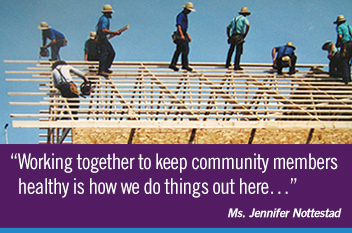A Unique Take on Patient-Centered Care in Rural Wisconsin
"Working together to keep community members healthy is how we do things out here," says Ms. Jennifer Nottestad, Patient Care Manager at Scenic Bluffs Community Health Care Centers. "Because we're a Federally Qualified Health Center and relatively small, we can't have one person do just one job," she says, noting that her entire team is willing to go above and beyond to improve processes and learn new techniques to get patients the help they need to live healthier lives. "We have to make things work. Our team members are willing to step up and take on an extra job or responsibility." 
This dedication to patients comes with a personal touch. "We're a pretty unique place," Jennifer adds. "There are times when patients will leave a voice message and fail to leave their name or phone number, and usually one of us can figure out who called."
Nestled in the picturesque, rolling hills of Cashton, Wisconsin, Scenic Bluffs Community Health Care Centers sits inside a renovated former bowling alley that still displays bowling pin icons from the building's earlier days. This is the second location for the practice, which had humble beginnings as a mobile unit operating in a bus 22 years ago. The original bus driver, Ms. Karla Amundson, is still on staff at the Health Center today, currently serving as an xray technician and patient scheduler.
There's also a hitching post and horse barn on site, which helps members of a large Amish community nearby get care from one of the Health Center's three primary care clinicians, Dr. Elizabeth Bade, and nurse practitioners Ms. Sherry Harris and Ms. Stacey Markuson. Scenic Bluff's Amish neighbors, who mainly visit when they're sick, make up around 8 to 10 percent of the clinic's 2,600 primary care patients. Other patients include members of rural farming families and residents who work at a nearby meatpacking plant, a growing number of whom are Spanish-speaking.
"Our team members are willing to step up and take on an extra job or responsibility."
Seeing patients regularly and performing follow-up visits is key for the Health Center; however, the Scenic Bluffs team acknowledges that providing in-person care can be a challenge due to patients' personal financial issues. The primary care staff often gets creative in finding ways to help, such as linking patients to additional services like payment support and housing assistance, or finding cheaper alternatives to medications.
The team at Scenic Bluffs also pays close attention to their patients' progress. "For example, we aim for 75 percent of our patients who have high blood pressure or diabetes to be able to manage their own conditions, like keeping their blood pressure or blood sugar below a certain level," says Jennifer. "If we have trouble meeting or maintaining this goal, we try to figure out what’s happening. Are patients not coming in? Did they stop taking their medication because they can't afford it?" The team focuses on educating these patients so they can successfully manage their health conditions day to day.
At Scenic Bluffs, making community members healthier and giving them personal attention is always top of mind. "These days, there's a greater emphasis on having a provider you know, who will be more attentive when you need a little extra assistance," says Jennifer. "We'll do whatever it takes to make sure our patients are getting the primary care they need."
This story is courtesy of Healthy Hearts in the Heartland, the EvidenceNOW Midwest Cooperative.



